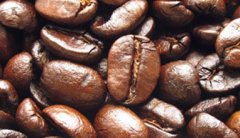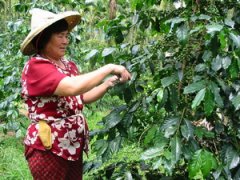Three native species of coffee, Arabica, Robusta.

Coffee, we generally refer to the finished product: the coffee we drink, also refers to coffee beans. Coffee belongs to the evergreen shrub of the genus Coffee of Rubiaceae. Coffee has some medicinal effects, such as waking up the brain, strengthening the stomach, stopping bleeding, dissipating heat, strengthening the body, etc., hee hee, if anyone is blinded by love, have a cup of coffee to wake up!
There are about 40 species of coffee, but the only ones that can produce coffee beans with commercial value are Arabica, Robusta and Liberian. these three species are called the "three native species of coffee". But most of the coffee in circulation on the market are Arabica and Robusta.
According to the statistics of ICO (international coffea organizations International Coffee Organization), excluding the domestic transactions of coffee producing countries, about 65% of the coffee in circulation in the world market is Arabica and 35% is robusta.
The Arabica species (coffea arabica) has a flat bean shape, slender granules, similar to oval shape, high quality aroma and sour taste, 5mur6m in height, cultivated in a low altitude area of 500m-2000m, not tolerant to low temperature and high temperature, not tolerant to heavy rain and little rain, weak resistance to leaf rust, and poor resistance to leaf rust. Within about 3 years, it originated in Ethiopia, among the three primary species. Arabica is of the best quality.
The coffea robusta Linden is originally a mutant of the coffea canephora, but it is customary to compare the robusta with the Arabica rather than the Congolese. Robusta bean type is relatively round, sour is not obvious, but has a unique bitter taste, the flavor is similar to fried wheat, is known as "Luobu flavor". The flavor is very strong, mainly used in instant coffee, bottled coffee, liquid coffee and other industrial production of coffee. But the caffeine content of Robusta is about 3.2%, which is much higher than 1.5% of Arabica. The height of the tree is about 5m, the cultivation height is less than 500m, it has strong rot resistance, high temperature and rain tolerance, and has stronger resistance to leaf rust than Arabica. The main producers of Robusta species are Indonesia, Vietnam and West African countries with C ô te d'Ivoire, Algeria and Angola as the center. In recent years, Vietnam is more committed to becoming one of the major coffee producers and including coffee production in its national policy. Hey, this is one of the answers to Mr. Eric's question about why Vietnamese coffee can be sold for 0.5 yuan a cup. First, quality; second, culture; third, quantity. But Vietnam also produces some Arabica coffee.
Coffea liberica does not want to go into great detail here, because his trading scope is very small, usually not used, what we are talking about is not very often, so let's briefly describe it here. The origin of Liberian coffee is in West Africa, and it has strong adaptability to all kinds of environments, such as high and low temperature, damp or dry, except that it is not resistant to leaf rust, and Arabica species are not resistant to leaf rust. However, the flavor of Liberian species is worse than that of Arabica species, and the bitterness is extremely severe, so it is only traded on the domestic market in some West African countries, or planted for research. Bean-shaped spoon-shaped, large, tree height of 10m, cultivated in the height of less than 200m, strong rot resistance.
Important Notice :
前街咖啡 FrontStreet Coffee has moved to new addredd:
FrontStreet Coffee Address: 315,Donghua East Road,GuangZhou
Tel:020 38364473
- Prev

Freshness is the life of coffee How to determine the freshness of coffee beans
Freshness is the life of coffee There are three steps to determining the freshness of coffee beans: smell, look and peel. Smell the coffee beans close to the nose, smell deeply, is it possible to clearly smell the aroma of coffee beans, if it is, the coffee beans are fresh enough. On the contrary, if the aroma is weak, or if it has begun to smell greasy (like peanuts or nuts), it will last for a long time.
- Next

Beautiful coffee trees, flowers, fruits and beans
Let's take a look at the coffee trees, flowers, fruits and beans, which are rarely linked together. Coffee tree coffee flower coffee fruit coffee raw bean coffee ripe bean
Related
- Detailed explanation of Jadeite planting Land in Panamanian Jadeite Manor introduction to the grading system of Jadeite competitive bidding, Red bid, Green bid and Rose Summer
- Story of Coffee planting in Brenka region of Costa Rica Stonehenge Manor anaerobic heavy honey treatment of flavor mouth
- What's on the barrel of Blue Mountain Coffee beans?
- Can American coffee also pull flowers? How to use hot American style to pull out a good-looking pattern?
- Can you make a cold extract with coffee beans? What is the right proportion for cold-extracted coffee formula?
- Indonesian PWN Gold Mandrine Coffee Origin Features Flavor How to Chong? Mandolin coffee is American.
- A brief introduction to the flavor characteristics of Brazilian yellow bourbon coffee beans
- What is the effect of different water quality on the flavor of cold-extracted coffee? What kind of water is best for brewing coffee?
- Why do you think of Rose Summer whenever you mention Panamanian coffee?
- Introduction to the characteristics of authentic blue mountain coffee bean producing areas? What is the CIB Coffee Authority in Jamaica?

